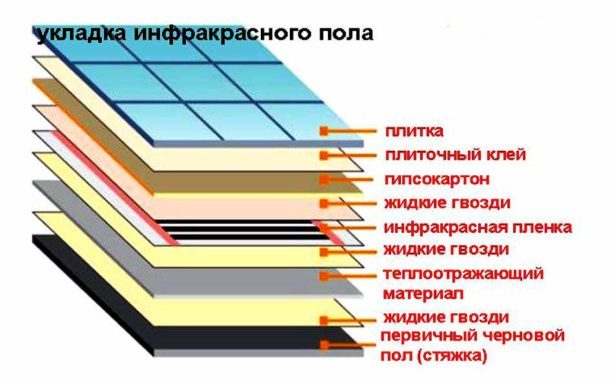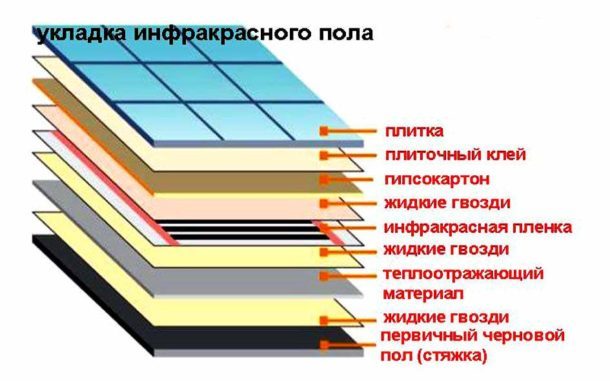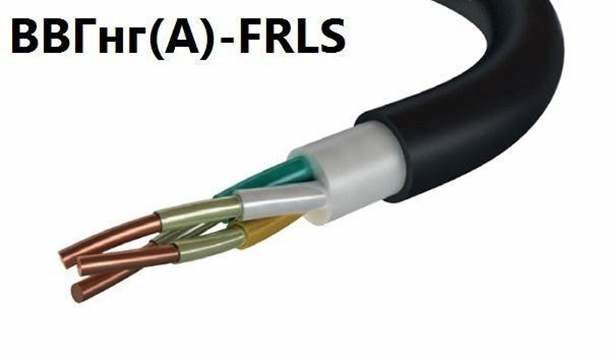Content
- Types of underfloor heating
- Water heated floors
- Electric underfloor heating
- Is it possible to combine film warm floors and ceramic tiles?
- Preparatory work
- Heat film laying
- Laying tiles
To create comfortable conditions in rooms where the floor is made of tiles, a system of warm floors is often used. Traditionally, in tandem with tiles, water or electric heating is carried out using cable or heating mats. However, many are interested in whether it is possible to put an infrared warm floor under the tile. Let's find out how to do this and how appropriate such a combination is.

Types of underfloor heating
Modern technology of underfloor heating involves two types of heating source: it is water and electricity.
Water heated floors
They are tubes with a coolant, placed under a thin screed and floor covering. In fact, these are modified heating radiators. Therefore, this type of heating can be used both in combination with the traditional scheme, supplementing it, and independently, replacing it completely. The disadvantages of water heated floors include:
- A significant amount of screed, which not only reduces the height of the room, but also significantly increases the load on the floors.
- The possibility of leakage in the event of a leak in the system, which is fraught with flooding of neighbors from below. And this can lead to very significant financial losses.
- In the event of a power outage or hot water during the cold season, the pipes of such a warm floor can defrost. As a result - large-scale system repair.
- Installation of water heat-insulated floors quite complicated, so not everyone can do it with their own hands.

Electric underfloor heating
The bulk of them are divided into three groups:
- Cable. The heating element is made in the form of a cable fixed on a special tape or metal mesh. When laying, they require careful calculation of the required cable length, as well as a fairly solid coupler with a height of 30 to 50 mm.
- Heating mats. Most often this is the same cable, but mounted on a fiberglass mesh. Such warm floors are much easier to install and require less screed - up to 30 mm. Tile glue can also play a role of screed: in this case, heating mats are placed in its thickness.
- Film: heating elements are placed in a fairly thin film. According to the material of the heating elements, carbon and bimetallic (copper and aluminum) types of film underfloor heating are distinguished. Unlike the first two groups of electric heating systems, heat transfer is mainly due to infrared radiation, which is why they are often called infrared warm floors.
USEFUL INFORMATION:How to paint wooden floors in an apartment: a review of materials

Is it possible to combine film warm floors and ceramic tiles?
Before laying the infrared floor under the tile, you should decide: is it worth it? The opinions of professionals in this regard are ambiguous.
Installation of an infrared heat-insulated floor is primarily advisable for such types of flooring as laminate, linoleum, and carpet. But with tiles, the situation is more complicated.
Opponents of laying film underfloor heating under tiles put forward the following arguments:
- Directly, the heating film itself has extremely low adhesion, which leads to the risk of peeling of the screed or glue from it. This, in turn, can lead to undesirable consequences such as the appearance of voids and cracks in the screed.
- Greater energy consumption than using heating cable or mats.
- The gradual erosion of the film by adhesives having an alkaline base cannot be ruled out.
- Laying a film underfloor heating under the tile is quite difficult. Extreme caution and accuracy must be observed. At the same time, to achieve the desired effect, it is quite simple to lay cable or matte electric heating elements.

But there are a number of advantages of this material, considering which, you can decide to perform the laying of an infrared warm floor under a tile:
- Minimum screed thickness. If there is no way to painlessly reduce the height of the room, then film floors are the only option to provide tile heating. A screed of not more than 8-10 mm will be required.
- Such warm floors are more reliable. If the elements are connected in parallel, then the failure of one of them will not lead to a failure of the entire system. Damage to the cable or the conductive circuit of the mat will inevitably lead the heating system to an inoperative state.
- Infrared heating elements are not sources of electromagnetic radiation.
USEFUL INFORMATION:Floor covering in the apartment: what is better to do?
Given the features of the system, we can conclude that it is advisable to use infrared film floors for tiles in small rooms with low ceilings.

Preparatory work
Like any other underfloor heating systems, infrared film requires careful preparation of the base:
- It is necessary to eliminate the protrusions and gloss over cracksavailable in the base surface.
- To lay the wiring and install the thermostat, grooves are made in the wall. As a rule, the thermostat is placed near the switch. It is more comfortable. If necessary, a groove in the floor is hollowed out to accommodate the temperature sensor.
- A thermal insulation layer is laid, professionals recommend a perforated isolon with a heat-reflecting foil surface. The thermal insulation is laid with the foil side up, so that the heat goes back to the room, and is attached to the base with metallic tape.

Along the perimeter of the room at a distance of 20 cm from the wall, insulation is not laid. This is done in order to provide a more reliable fastening to the extreme tiles.
- It is necessary to paste the floor around the perimeter with a special conductive tape. It will serve as a kind of grounding. Power supply of heating elements must be carried out on a separate line with the mandatory use of RCDs.
- A styling scheme is drawn up. Heating is not done under heavy stationary furniture, at least 40 cm must be retreated from the walls.
In order to save money, you can lay infrared film under the tile only in those places where you will walk. Get a kind of warm track.

Heat film laying
A set of infrared warm floors necessarily includes detailed installation instructions. Many manufacturers even supply the product with CDs, where everything is described in steps. But it will be useful to know some of the nuances of laying the film:
- The film is not laid in a continuous array, but at intervals of 50–100 mm.
- Do not allow overlapping strips one on top of the other.
- To fix the elements on thermal insulation, use adhesive tape.
- It is necessary to cut the film along special cutting lines.
- It is better to place elements with contacts in the direction where the thermostat is located. This will reduce the length of the wires.
USEFUL INFORMATION:How much should the screed dry? SNiP 3.04.01-87

- So that the wires do not protrude above the surface of the film in thermal insulation, special grooves can be made under them.
- According to the instructions, a clamp for connecting electricity is attached to the copper strip. After connecting the wires, all contacts must be reliably protected with bitumen insulation or heat-shrinkable insulating tubes.
- A temperature sensor is installed. It can be located in a special gate, in a corrugated tube. Its end is securely closed with a cap. With another placement option, it is attached under the film, for which a hole of the corresponding shape is cut out in the insulation.
- Connection to the thermostat is in progress. If you are not confident in your abilities, then it is better to use the services of a professional electrician.
- After checking the system’s operability, a layer of ordinary plastic film spreads, which is fixed with tape.

Laying tiles
Laying tiles can be done in two ways:
- A paint net is placed on top of the film, onto which a screed 8–10 mm thick is poured.
- Plaster can replace the screed. Their fixation must be carried out very carefully in those places where there are gaps between the individual bands of the infrared film.
Himself tile laying process will differ from the standard only in that the glue and grout must be designed for underfloor heating.

EXPERT SITE
Tsugunov Anton Valerevich
Master Station Wagon
- Since 2003, I have been engaged in the repair and decoration of premises.
- Over 100 completed objects.
- I appreciate the quality, more than the quantity!
Personal page >>>
Friends!
I offer you the service "Friend Builder"
As this site develops, subscribers and visitors are turning to me more and more often asking for help with advice on various issues of repair and decoration.
Questions are sometimes asked very complex and interesting. You can’t write an article for each situation, so I decided to advise you individually.
Thanks to you, friends, a new direction of my favorite work has been born - share your experience and benefit everyone who is undergoing repairs!
Get a one-time consultation from me >>>
Order full apartment repair support >>>


